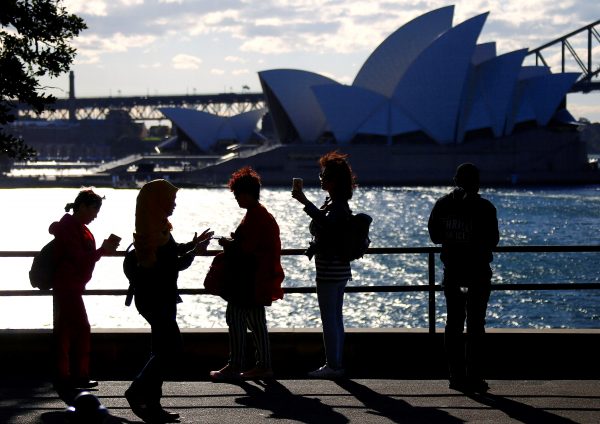Moderate population growth through immigration helps achieve a sustainable demographic profile and expanding economy. Domestic savings cannot fuel the vast investment opportunities and foreign capital has made sectors from tourism to mining what they are today — global leaders.
As a small open economy, were Australia to embark on a course of economic isolation, of the kind embraced by many US and European voters in 2016, the consequences for the country would be uniquely catastrophic.
Is it possible that Australia could have its own ‘Trump moment’ and shoot itself in the foot?
The Australian economy has enjoyed more than a quarter of a century without a recession. Despite recent rising global iron ore, coal and gas prices, the commodities boom is over and the economy needs to transition away from heavy reliance on natural resource exports. During the commodities boom the already uncompetitive automobile industry, and other manufacturers, were decimated with the exchange rate appreciation associated with rising incomes across the nation.
The economic adjustments that took place and that are needed now are large and daunting. That almost certainly explains some of the political instability Australia has experienced despite a continuously expanding economy. Politically, the last 10 years have seen six changes of leadership, as well as the steady rise of smaller parties and independent politicians, many of whom tap into community anxiety, xenophobia and protectionist instincts. The ruling Liberal–National coalition garnered just 42.1 per cent of votes in last year’s election — a share that 10 or 20 years ago would have likely represented a hopeless loss. Independent and third-party candidates received an all-time high of 23.1 per cent of the vote in the lower house.
Some Australians have felt disempowerment, like many in America, the United Kingdom and Europe. And it is easy for politicians to pander to these fears, fanned by the minority right. But while the political pressure to become more isolationist from the fringes seems to be getting stronger, the two main political parties, and mainstream society have held firm on economic openness and migration.
Can that continue?
There is hope yet that Australia will dodge the isolationist wave, as David Vines argues in this week’s lead essay. The country’s record of economic policy innovation that has served it so well until now might suggest that it can continue to navigate and manage the pressures to avoid looking inward and the shocks from the international system. But there is no guarantee.
Australia’s high degree of economic interdependence has motivated its macroeconomic policy framework since World War II. ‘Because of Australia’s international vulnerability’, Vines observes, ‘the form of Keynesianism adopted by Australia’s economists was, from the very beginning, of an open-economy kind’.
In the wake of 1970s stagflation, Australia, like many other countries, was forced to re-assess its macroeconomic approach. This meant moving away from centralised wage fixing, floating the exchange rate and opening up new markets to Asia. The pace of reform during the Hawke and Keating governments (1983–96) now seems staggering. These reforms made possible a period of transformative growth in trade and productivity; while a measure of fiscal discipline, a timely move to inflation targeting, and a cautious approach to financial regulation kept crises at bay.
Throughout these changes, writes Vines, the ‘Australian political economy… retained a powerful and distinctive concern for fairness, and a determination to moderate income inequality’. A lasting regard for fairness as well as growth is ‘an important part of the reason why there has not been a working-class rebellion against Canberra, like that directed against London and Washington’.
The commodities boom helped keep Australia’s economy from falling into recession during the global financial crisis but, as Vines explains, Australia macroeconomic policy and its framework managed ‘the fall in terms of trade in the mid-1980s, the Asian financial crisis in 1997–98, the global financial crisis and the commodity price collapse in 2014–15’ remarkably well.
Australia’s institutional strength, the legacy of decades of creative economic policymaking, has bought it time. Now the country’s policymakers must continue to push for structural change. What is needed in Australia is transformation of the resource economy as the relative role of mining declines. Services, high-value manufacturing and agricultural exports are where the economy needs to move to and innovation is the right focus.
As the Australia–China Joint Economic Report makes clear, this transition coincides with and is complemented by the structural changes China is trying to effect. The transition already underway of the Chinese economy from an export and investment-led to a services and consumption-led economy opens up complementary opportunities. China is already by far Australia’s largest economic partner. As the Chinese middle class grows, so will its demand for high quality services, agricultural produce and niche markets.
China will be the largest part of the external story for Australia’s economic transformation and reinvention. But the rest of Asia will be more important in the decades that follow. Australia already trades more with East Asia than any other Asian country and with young and poor populations throughout Asia the growth potential will remain high for decades to come.
These opportunities will not be realised and the structure of the economy will not change automatically from a weaker Australian dollar alone. Investment in capabilities and Asia literacy will be needed. At the centre, political leadership is needed to hold the line against becoming inward-looking and to keep Australia open to trade, investment and migration.
Australia is an exemplar of success in globalisation with its high stakes in Asia. Australian policy settings have ensured that the benefits of this have been enjoyed across the community. But the macroeconomic policy strategy and policy framework that delivered economic growth and helped to moderate inequality needs continuous investment of political capital and their reinvention must respect the legacy which was the foundation of success.

